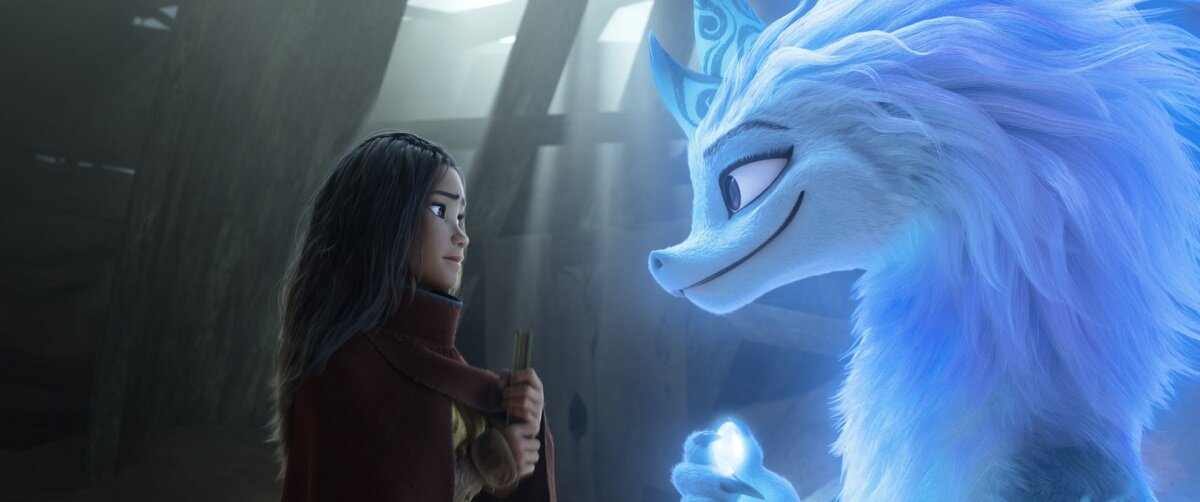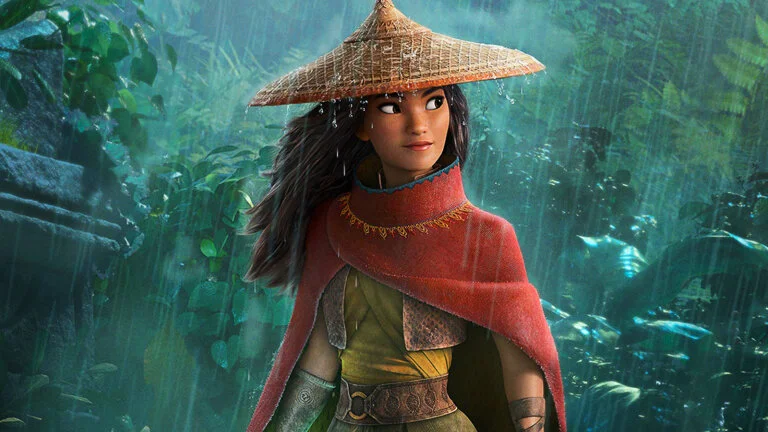'Raya and the Last Dragon' Review: Disney's First Southeast Asian Princess Packs a Punch
With ‘Raya and the Last Dragon’ hitting screens this week, Disney’s new pants-wearing princess shows audiences how the House of Mouse does dragons.
If there is another character synonymous with Disney, other than He-Who-Must-Not-Be-Squeaked, it is the faceless concept of a young woman in a skirt of any length, roaming the halls of a palace, town square, or island while singing of a better life - the Disney princess. You can put her in Western Europe; you can put her in the Middle East; if you want, you can put her inside an arcade game; drop her anywhere, but just put her in that skirt and give her a song. Throughout its many eras, the House of Mouse has been so stringent upon maintaining a thread of princesses that meet one or more of these requirements, that even those who are supposed to be deviations of the formula still have the damn skirt on (looking at you, Moana and Vanellope.) It's hard to think that any single character would ever break the spell. Then along comes Raya.
An undisguised departure from the animation studio’s usual feminine fancies, “Raya and the Last Dragon” wears its influences on Raya’s pant sleeves. The most notable element of the film, both in its practice and word-of-mouth, is its relationship with Southeast Asian culture. At any given moment until the release of the film the rumors and press surrounding Raya’s origins would shapeshift from Malaysian to Vietnamese, from Singaporean to Indonesian. Several articles have called out Raya’s Filipino detailing such as her hat, reminiscent of a traditional rural salakot, and her weapons, similar to the bastons used in the national martial art of the Philippines, arnis. Needless to say, many cultures were ready to call Raya their own, but the Guardian of the Dragon Gem belongs to no one.
Raya (Kelly Marie Tran) and her father, Chief Benja (Daniel Dae Kim), good-intentioned and wealthy, are keepers of the Dragon Gem--- a dragon-made orb that saved the world from The Druun (a hive-mind of monsters), but ended up in the petrifaction of its creators as well. Centuries later, the land once co-inhabited by humans and dragons, united as “Kumandra”, has separated into 5 regions: Fang, Heart (Raya’s home), Spine, Talon, and Tail. Needless to say, the whole place suffers from more than a little tension. During an attempt to reunite the people of the nation, Raya, in an act of blind trust, inadvertently causes a fight that shatters the gem, freeing the Druun, and encasing much of the regions’ population in stone...including her father. With each faction collecting a piece of the gem, an uncaged monster hungry for destruction, and a heavy burden on her shoulders, what else is there to do except plan a road trip?
The film is Disney’s biggest road trip since “The Emperor’s New Groove”. On Raya’s quest to locate the orbs, she discovers and befriends the last dragon, Sisu (Akwafina), who joyously decides to join the party. The rest of the film is carried out in a methodical and familiar manner. Stones are scattered, let’s get them back to save the world. Infinity Gauntlets, anyone? There is a clear path and a clear lesson involved in the storytelling of “Raya” that makes the film a pleasant ride, but perhaps the most predictable watch in Disney’s new canon of 3D animation. Regardless, the action sequences are polished and swooping, going to toe with some of the best animation in their vault. Its cinematography is able to create a sense of immediate danger and intimacy with each fight in the film. “Raya” does its due diligence paying attention and homage to different fighting styles of various Southeast Asian cinema. And although its events don’t take place in a specific real-world region, It manages to pull off a film that doesn’t feel inauthentic in style and tone. So, in regard to detailing and representation, “Raya” is more than successful.
The cast is Asian, which is a big win for an animated movie about non-white people. Gone are the days of Scott Weinger, Full House’s Steve Hale, voicing Aladdin. The only non-Asian voice we hear is Alan Tudyk, providing the whimpering of Raya’s giant armadillo, Tuk Tuk. I think we can let that slide. There was a lot of care (quick care, but care nonetheless) put into the diversity and talent in the film. Perhaps the voice of the film, if not Kelly Marie Tran’s Raya, is Akwafina lending her vocal chops to the other titular character of the film. Lending her distinctive vocal chords to both a neurotic, overly friendly water spirit and the New York City MTA, Akwafina’s resume as the voice of necessary but somewhat defunct cultural staples is growing longer. It works quite well, but the movie really does not hold back on showcasing that it is indeed Akwafina behind the microphone. Sisu’s human form looks hauntingly similar to the actress if someone had given her a periwinkle wig and some THC. If the film is wearing its Southeast Asian influences on its sleeve, Disney is wearing Akwafina on its shoulder, holding up a neon arrow and a bullhorn. And hey, anyone would.
The rest of the cast is just as vibrant. Gemma Chan as Namaari, Raya’s rival and unrequited eye candy, delivers a sinister yet tender snarl, and Issac Wang as Boun, a tweenage chef/boat captain/guerilla rebel, steals every bit of time on screen. There is another character, voiceless for the most past, who provides some of the most baffling moments of any Disney film, that would be a crime to spoil for any audience. The landscapes are rendered beautifully, and each region feels like it represents a singular country within the real-life region that the film is emulating. Why Disney now chooses to hide its aversion to country-unspecificity behind an incredibly well researched culture-quilt will is another question, but the whole film from head to toe is dressed in different types of authenticity. It’s enough to sustain the obvious nature of the quest. Alas, plotting, character, and design aside, there’s a yearning that comes with watching something predictable and formulaic. For as exquisite as “Raya” looks on the outside, its inner mechanics of the dragon are a tad sticky.
The slightly more frustrating aspect of the film is the way its themes, trust, duty, and honor, are portrayed; not in the sense that they are mishandled, but regard to the audience’s yearning for more. If Raya is truly to be coined by the studio as their first “Southeast Asian” princess, and the film is planning on staying true to the struggles of those regions, the meat and potatoes of the film, what the movie is actually about, loyalty versus faithlessness, trust vs suspicion, duty vs morals, simply do not go far enough to reach the spiritual (yes, spiritual) satisfaction that the movie intends to achieve. “Raya” is a film deeply tied to the idea that an overarching belief system can unite, or in this case, reunite, a people.
For anyone who has been alive for the last several centuries, uniting over spirituality is kinda sorta a tad bit complicated. Yes, Raya is for children who want to buy stuffed animals and Halloween costumes, but for those who feel a deep tie to the ideas presented during its runtime, it leaves a hankering for something more. The studio on several occasions has proven that it's been able to take big ideas and show their complexities and pitfalls. “Frozen” on the notion of true love, “Tangled” on codependency, “Wreck it Ralph” on purpose are examples of when Disney does not feel rushed in its execution. And for as wonderfully action-packed, funny, and subversive as “Raya and the Last Dragon” is, the film sometimes uses its charm to cover up over potholes on the road to the last gemstone shard.
With such specific lore, large contemplations on big ideas, and a character who is a literal god of the movie’s world, “Raya” doesn’t feel like it should be a simple film. Simplicity isn’t always worth harping over, but at times it does feel like a boiled down, cuter version of “The Lord of the Rings” or “Avatar: The Last Airbender”. And though those things are great and Disney has not ventured into that realm of fantasy in a long while, audiences have. Especially with a conventional “gathering of materials” plot, it leads one to believe that the creative process, at least the nitty-gritty-thinky-brainstormy process, was a little rushed.
“Raya and the Last Dragon” was announced in August 2019, the same year that the “How to Train Your Dragon” trilogy had ended, “Game of Thrones” had breathed its last breath, and other dragon-related fantasy properties were nowhere to be found. Fast forward less than two years later to the film’s release, and it starts to paint the picture of a studio wanting to play catch up while also attempting to be the new face of the subgenre. Motives aside, at the end of the day, the film is a touching, well detailed, funny, action-packed, strategic film to include in the studio’s list of chess pieces. And as the credits roll, the studio’s desire for a future of a “Raya and the Last Dragon” franchise is fairly clear. Disney wasn’t the first dragon to crack the dragon-obsessed zeitgeist, and with a story that has sequel-spawning, merchandise-making, draconic world-building potential, they certainly will make sure “Raya” will be the last dragon standing— with or without a dress.



